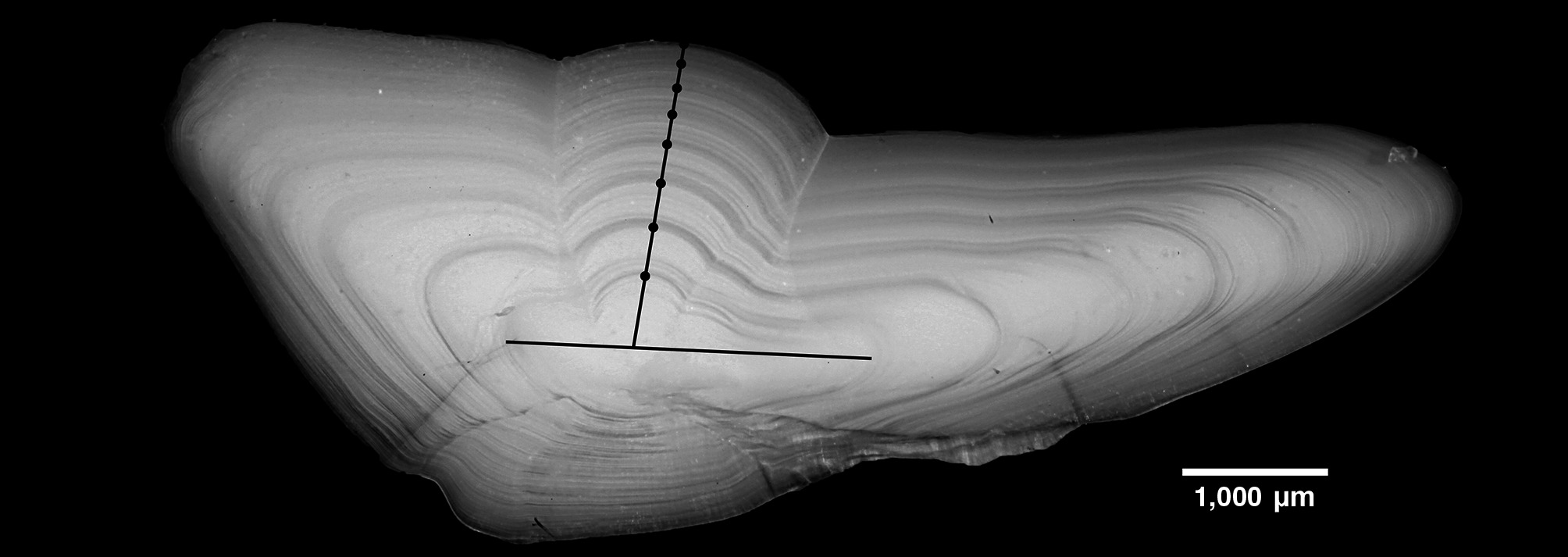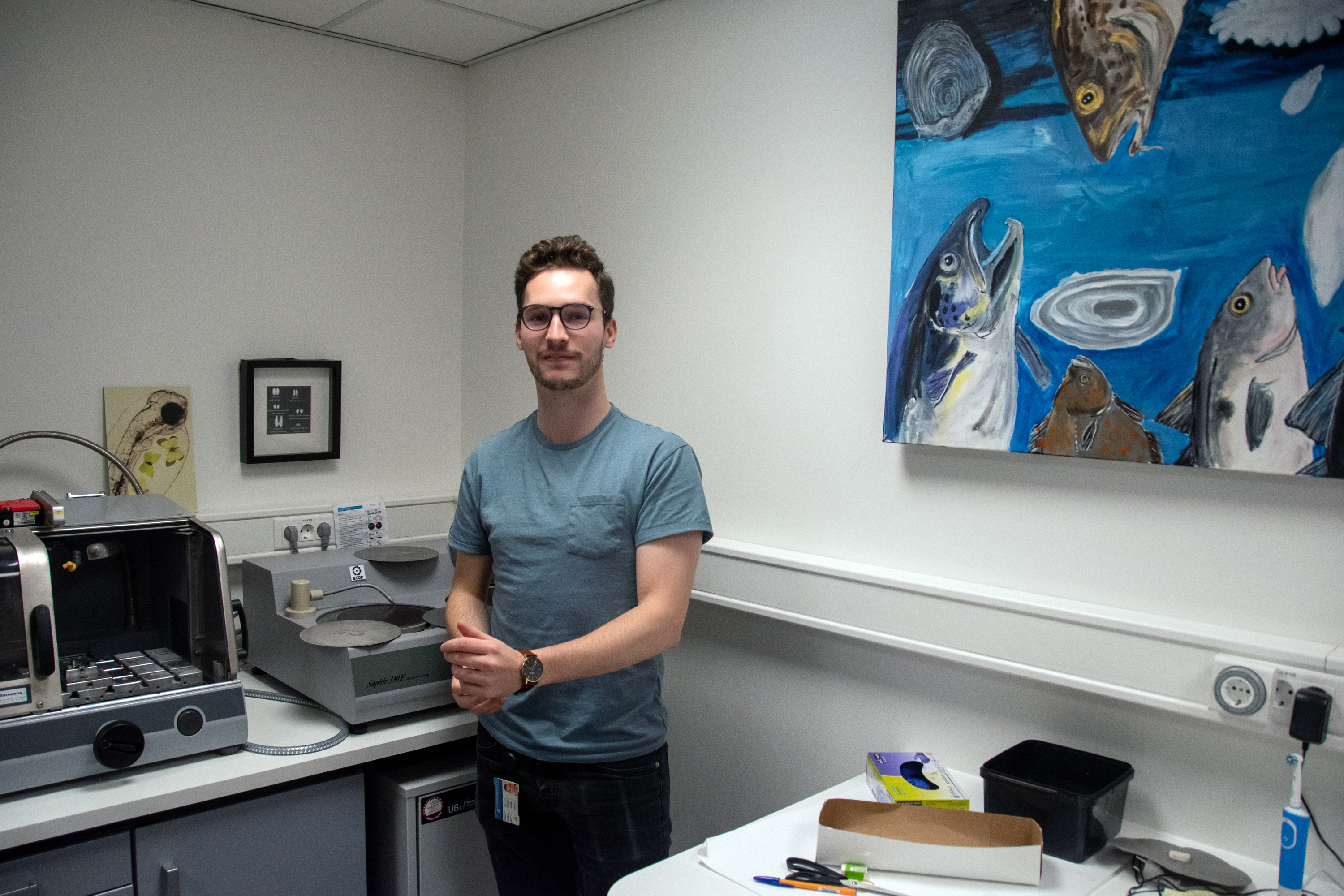What a century of otoliths tells us about the life and growth of cod

Skrei spend most of their lives in the Barents Sea, but they travel to Lofoten to spawn. Their otolith reveals how long they have lived and how much they have grown each year.
Photo: Erling Svensen (left), Côme Denechaud et al.
Côme Denechaud started working with otoliths when he studied the diet of tropical fish in his master’s degree. He hadn’t studied cod until he came to Norway to join the Institute of Marine Research’s research group for demersal fish and the University of Bergen's doctoral research school.
Photo: Runar Bjørkvik Mæland / Institute of Marine Research
The otoliths are covered in epoxy resin and put in the machine in the background, where a diamond blade cuts a thin section out of the otoliths.
Photo: Runar Bjørkvik Mæland / Institute of Marine Research
Cod otoliths
Photo: Anders Jakobsen / Institute of Marine Research
At the Institute of Marine Research’s otolith archive, millions of otoliths are stored in boxes and paper bags, labelled with the place and date when they were obtained. The oldest ones date back to the start of the last century.
Photo: Anders Jakobsen / Institute of Marine ResearchPublished: 08.10.2020 Updated: 27.10.2020
If you have the otolith from a single Northeast Arctic cod or skrei, you can see how old it is and how much it has grown each year. But if you have four thousand of these otoliths, you can see how the population has developed over time.
In a recent study, marine scientists have done exactly that. The findings, which were published in Global Change Biology, could provide important information about how the population is affected by changes in environmental conditions and human activities, including future ones.
Large amounts of information
The otolith is the fish’s “data logger”. Each year of its life, a fish produces a new ring in its otolith, like the rings in a tree. The distance from one ring to the next is indicative of how much the fish has grown each year.
“When a fish grows a lot, its otolith also grows more. When you measure the rings in an otolith, it offers a window into the cod’s life”, says PhD student and main author of the study, Côme Denechaud.
In the Institute of Marine Research’s otolith archive down by the quays in Bergen, he sampled the otoliths of around 4,000 cod that had been caught in the Lofoten archipelago between 1933 and 2015. The oldest fish had been born as long ago as 1924.
Lofoten is where the skrei famously go to spawn.
Hoped to find and explain variations
The researchers used a slicing machine with a diamond blade to cut millimetre-thick sections of the otoliths, which they then photographed. Next, they measured the distance between the growth rings, and matched each ring up with a year in the time series.
The researchers wanted to find out how much the growth rate of cod varied during the period in question, and what factors might explain that variation.
“If we see that a cod has grown quickly during the first three years of its life, before growing more slowly in subsequent years, we can try to produce a model to explain why. Perhaps it was colder in the later years, and the temperature had an impact on its growth”, says Denechaud.
“That is basically what we have done, but in a large model incorporating 4,000 fish and over 30,000 measurements covering 91 years, with each measurement representing one ring on an otolith”.

Competition for food has the biggest impact
Like other animals, cod grow fastest when they are young, and some cod grow more than others throughout their lives. The researchers therefore first created a model that smoothed out these natural variations in order to obtain a standardised growth rate per year.
Then they fed in data about various conditions that could potentially explain variations in growth: sea temperature, climate, fishing mortality and the total populations of cod, herring and capelin.
They concluded that the growth of the skrei was affected by several different factors. But the thing that explained most of the variation was simply the size of the cod population.
When there are a lot of cod in the sea, competition for food and other resources becomes fierce. Cod become ravenous cannibals and eat each other. That affects their growth rate. Technically, this is known as a density dependent growth.
“We found that the density dependence was the strongest driver of the cod’s growth variations over the past century”, says Denechaud.
Its impact was around three times bigger than that of the other factors examined in the analysis.
“The growth rate was up to 25 percent higher when the population was at its smallest as compared to when it was at its biggest. In recent years the growth rate has declined, mainly because the population is now very big”.

Fisheries and temperature also have an impact
Warmer sea temperatures also have a clear positive impact on the growth of the skrei. The impact of temperature is both a direct one on the cod, and an indirect one, because it improves conditions for capelin, an important prey of the cod.
But other factors also play a part. In the last years leading up to 2015, the impact of the Barents Sea being warmer was likely offset by the population being so large. Temperature changes may also affect other species that the cod is dependent on, and which are not as good at adapting.
The scientists particularly saw this at work during the 1990s, when a long period of below-average temperatures in the North Atlantic gave way to a warmer period. This shift in the climate had a big impact on ecosystems: some populations collapsed, while others exploded.
“This also affected the cod population in the Barents Sea: its growth rate fell, in spite of temperatures rising and the population being small at the time. We believe this was linked to the shift in the climate of the North Atlantic, which affected the distribution of water masses, the dynamic of prey populations and so on”, says Côme Denechaud.
However, it has been harder to identify an impact of annual cod catches on individual growth.
“Directly, the fishery didn’t have a significant impact on the growth of individuals. It may have had a small negative impact because large individuals were harvested. But indirectly it may also have had a positive impact by reducing the density dependent growth.

Using the past to understand the future
While Denechaud and his collaborators have worked on the time series on skrei – one of the largest of its kind in the world – another IMR researcher, Szymon Smoliński, has led the work on an equivalent time series for Icelandic cod as part of the same project. Their interest is not just historic.
“Identifying how a particular change in the environment has affected the population in the past gives you an idea of what could happen in the future. The main point of producing these models is that is makes it possible to do projections”, says Denechaud.
Hopefully, the historical analysis can serve as foundations for subsequent projections, which can in turn support scientific advice on marine resource management. At a time of increasing pressure on the ocean from climate change and industry, such information is more important than ever.
Gold mines
The first time Denechaud visited the otolith archive, it wasn’t entirely easy to find what he was looking for amongst all the shelves full of old cardboard boxes. Now the archive is being tidied up and digitalised, so it will be easier for researchers to use it in the future.
“These archives are gold mines. There is so much information that you can extract from an otolith, about the whole population, growth rates, maturation and environmental conditions”, he says.
Many other countries also have their own otolith archives. Otoliths have traditionally been used to determine species and age, but over the past few decades new research methods have expanded their potential applications. Suddenly, old samples can provide new answers.
“If we had wanted to do an equivalent study without otoliths, we would have had to measure thousands of fish each year for ninety years. With the otolith archive, we have the whole life story of fish in a small stone from their heads, and we can look back across a whole century”.
